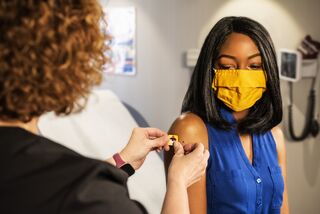Fear
Treating Needle Phobia: Vaccination Education Not Effective
Educating someone about vaccinations doesn't reduce needle phobia symptoms.
Posted September 25, 2021 Reviewed by Kaja Perina
Key points
- There are key risk factors for developing a fear of needles.
- A fear of needles is one of the main reasons people don't get vaccinations.
- Educating someone about vaccinations doesn't decrease needle fear symptoms.
- Other routes of vaccine delivery might help people with trypanophobia get medical treatment.

When we look at whether a fear of needles (trypanophobia) hinders a person from getting vaccinated against Covid-19, it is helpful to look at the data already available about avoidance of flu vaccinations. Both vaccinations have some common features — they are delivered by needle, they act as preventatives, and both can trigger a fear of needles.
In this article, you'll learn how often trypanophobia prevents people from getting vaccinated, your risk factors for developing trypanophobia, the role of education and how it doesn't necessarily decrease phobic reactions, and how changing the way you get a vaccination can make all the difference.
How often did people avoid the flu vaccine because of trypanophobia? Approximately 16% of adults, 27% of hospital employees, 18% long-term care facility employees, and 8% of healthcare workers at hospitals (McLenon & Rogers, 2018).
You May Have a Risk Factors for Developing a Fear of Needles
There are some risk factors for developing a fear of needles. According to Milovanović, et al. (2017) and other researchers you are more likely to develop a fear of needles if you have:
- Chronic illness in the family
- Childhood history of chronic illness
- A parent with a fear of needles
- Dentaphobia (Phobia of dentists)
- Osmophobia (Phobia of odors in the room)
- Misophonia (Strong dislike of particular sounds)
- Generalized anxiety disorder
- Previous bad experiences with blood draws or injections
According to answers on the Blood-Injection Symptom Scale (BISS), three factors contributed to the fear of needles — symptoms of fainting (vasovagal response), fear of the needle and consequences of the needle sting, and fear of the hospital and person taking blood or giving an injection (Milutnović, et al., 2021).
Education is Key...to a Point
Before first-year pharmacy students took an immunization training course, 73% thought immunizations were "very important" in preventing future pandemics. After the course, that number jumped to 94%. Before the course, 52% of pharmacy students were hesitant about giving injections; after the course that number dropped to 33%. However, the course did not change the percentage of students who had a fear of needles (Kubli, et al., 2017).
An educational pamphlet about reducing vaccine anxiety and pain resulted in 20% of study participants used at least one pain-mitigation strategy. More than half of the participants wanted to share the information with others. However, the fear of needles and self-reported pain was the same before the pamphlet and six weeks afterwards.
The fact that the amount of needle fear in both studies stayed the same speaks to the irrational fear that is part of trypanophobia. Eliminating a needle fear is not as easy as just educating someone about the injection or blood draw. If you've been told, "You know the needle is so tiny, I don't know why you're so scared," remind the person that a phobia is a medical condition and has nothing to do with what you know about needles. See my article on treating trypanophobia both immediately and long-term.
Route of Delivery Matters
Another route besides hypodermic needles may help people with trypanophobia get vaccinated. Undergraduates cited a fear of needles as one of the main reasons they didn't get a flu vaccine. They did indicate that they were more likely to get the vaccine if it was the nasal spray form rather than an injection (Ryan et al., 2019). Another option for getting the flu vaccine is through a microneedle patch. Microneedles provide extremely small pathways for medication to be absorbed via a transdermal patch. The needles are as thin as a strand of human hair, and can be made with 3D printers. One study found that participants preferred getting a flu vaccine via microneedle over nasal spray (Frew, et al., 2020). There is currently research being conducted on using microneedle patches for administering Covid-19 vaccines (Yin, et al. 2021).
References
Frew, P. M., Paine, M. B., Rouphael, N., Schamel, J., Chung, Y., Mulligan, M. J., & Prausnitz, M. R. (2020). Acceptability of an inactivated influenza vaccine delivered by microneedle patch: Results from a phase I clinical trial of safety, reactogenicity, and immunogenicity. Vaccine, 38(45), 7175-7181.
Kubli, K., McBane, S., Hirsch, J. D., & Lorentz, S. (2017). Student pharmacists' perceptions of immunizations. Currents in Pharmacy Teaching and Learning, 9(3), 479-485.
McLenon, J., & Rogers, M. A. (2019). The fear of needles: A systematic review and meta‐analysis. Journal of Advanced Nursing, 75(1), 30-42.
Milovanović, B., Tomović, D., Janković, S. M., Grubor, I., Nikolić, L., Nikolić, M., ... & Nikolić, M. (2017). Factors influencing the fear of needles among students of medicine and pharmacy. Acta Facultatis Medicae Naissensis, 34(2), 147-158.
Milutinović, S., Stanković, A., Ivanović, S., Trgovčević, S., & Kilibarda, T. (2021). Compilation and testing the reliability of questionnaires about the fear of blood extraction (venipuncture) among students of Medical Faculty of Kragujevac. Acta Facultatis Medicae Naissensis, 38(1), 85-95.
Ryan, K. A., Filipp, S. L., Gurka, M. J., Zirulnik, A., & Thompson, L. A. (2019). Understanding influenza vaccine perspectives and hesitancy in university students to promote increased vaccine uptake. Heliyon, 5(10), e02604.
Yin, Y., Su, W., Zhang, J., Huang, W., Li, X., Ma, H., ... & Wang, H. (2021). Separable Microneedle Patch to Protect and Deliver DNA Nanovaccines Against COVID-19. ACS Nano, https://doi.org/10.1021/acsnano.1c03252


